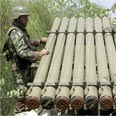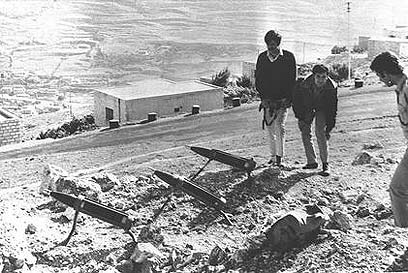
The first Katyusha attack
In September 1968, Israeli citizens encountered the fierceness of Katyusha rockets for the first time. A report on coping, fear, national resilience and response
As befitting an educator, the principal maintained his composure in the face of the onslaught that hit his house. He later told a Yedioth Ahronoth reporter: “I heard the cries of the wounded children and ran to them immediately. I treated them and called an ambulance.” The principal’s seven year old daughter who was standing next to the window at the time described the salvo of fire: “It was like lightning”.
It was apparently the first time the citizens of Israel met up close and personal with the rocket known as the Katyusha.
Katyusha, a brief history
Towards the end of the 1930’s, Soviet weapons factories developed two new types of projectile rockets: The 132mm BM-8 and the 83mm BM-13. In experiments conducted in 1938, the maximum firing range of the rockets was 5.5 km.
According to various sources, the Soviet artillery unit commanders were not too excited about the new weapon that had a clumsy mechanism and limited precision. But as in any war, one does not get to choose the processes. After the German invasion in 1941, the Katyusha began its regular service in the Soviet army and apparently was successful.
The Soviet rocket received its charming name from a popular song that captured the hearts of the Russian fighters at that time (“And Katyushka went out to talk…”) The German soldiers, who for obvious reasons tended to like the rocket less, gave it the nickname “Stalin’s organ” for the similarity between the launching barrel and the musical instrument.
During and after the war the Soviet army continued to develop and improve the rockets, a process which led to the creation of rocket engines and different launch models. In deference to tradition, the new rockets were also called Katyushas.
In the sixties, when there was a massive flow of weapons from the Soviet Union to Arab countries, the Katyusha also made aliyah to the Middle East, an event that was widely reported by Israeli newspapers.
The Katyusha made its first appearance in the Arab-Israeli conflict during the Six Day War, when they were used by the Syrian and Egyptian armies against the IDF. A short time after, it became clear that the Palestinian terror organizations, with Fatah at the head, were armed with Katyushas.
After the Six Day War, the IDF storehouses were full of captured weapons, including Katyushas. After analyzing the weapons, the IDF in 1971 established a Katyusha unit. The unit operated until the beginning of the Yom Kippur War, when all the IDF katyushas were destroyed and it fell into oblivion.
During the Lebanon War, the IDF collected as spoils Katyushas from PLO storehouses. Accordingly, the Chief of Staff at the time, Rafael Eitan, ordered a Katyusha unit to be quickly established. The new unit participated in the fighting in Lebanon until they finished the inventory of the ammunition, and then they disbanded.
On the line of fire
In 1968 the exchange of fire on the Israeli –Jordanian border was not an unusual event. The PLO, who was situated on the eastern bank of the Jordan Valley, was getting progressively stronger. This led to violent Palestinian attacks and Israeli reprisals.
Despite this, Bet Shean, located six km from the border, was usually out of the line of fire, with the communities surrounding it on the east receiving the brunt of the attacks. Even though there were some warning signs (three months prior some bazooka bombs with their delay mechanism pointing towards the center of Bet Shean were found by chance) the residents of this sleepy town were not ready for the events of September 16.
At around 7:45 PM the first Katyusha landed in the center of Bet Shean, 250 meters from the roofless movie theater, which at the time was occupied by dozens of children. Immediately afterwards another seven rockets fell, injuring eight residents, including two young girls. Three of the injured were admitted to the hospital and the rest were treated and sent home.
The Katyushas brought some celebrities to Bet Shean, including Defense Minister Moshe Dayan, who came to strengthen the people and left strengthened himself. He arrived at the local council hall to applause and entreaties to order the IDF to react with full strength.
The press came to Bet Shean to report on how the far off periphery was reacting to suddenly becoming the war front. An article from Yedioth Achronoth at the time confirmed the optimistic belief that in spite of the bombardment everything would go back to normal.

Katyusha, 1974 (Photo: GPO)
“Ten minutes after the first Katyusha, the residents of Bet Shean were already in their shelters. Instructions were given to the residents by a police car that traveled through the city. At around nine o’clock at night the all clear siren was heard and the electricity went back on.”
The paper also quoted residents offering testimony to city’s ability to withstand the challenge imposed on it: “My feeling like everyone in Bet Shean is that bombs are not good, but we have to overcome them. I saw many women and children crying, but no one is thinking of leaving. This is the fate of the whole country and we have to find the strength to overcome the fear”. (Housewife, mother of two)
“When Dayan came and shook my hand and wished me a good new year. I thought that everyone in this country is a brother. I said to myself: Buzgalo, there is no fear. Those bastards won’t chase us from here”. (Worker, father of six).
Home front
It appears that like today, the civilian front is strong and able to withstand challenges. Only at the periphery does one hear slight criticisms about the amount of shelters in the city.
A few days later, the bombardment on Bet Shean gets pushed to the inner pages of the paper, where slowly a more complex picture is revealed. For the twenty thousand residents of Bet Shean, there were not too many shelters and most of them were locked during the bombardment, leaving the residents terrified and searching for improvised shelter.
One of the residents of Bet Shean, an army medic, shared his personal testimony of fear with a Yediothh Ahronoth reporter:
“I ran toward the clinic and felt the ground shaking. Frightened people were running in the dark streets. It’s impossible to be brave at a time like that. Everyone was worried. I ran into a woman who was in shock and I took her to the clinic…Suddenly, I remembered that my youngest son was at the movie theater.
"I ran in that direction and luckily ran into him, standing by himself and crying. I grabbed him and began to run home…I saw lightning a few meters on the left. The explosions were terrifying. The thrust pushed me onto my son, and I stayed on top of him to protect him. I heard injured children inside Abu’s house crying for their mother.”
With the understanding that this first Katyusha salvo would not be the last, local council head Yaakov Machluf tried to arouse public awareness to the lack of shelters in the city:
“The attack came as I was sitting in a meeting. I went out to the street and saw dozens of men, women and children clinging to the outer walls. They were searching for shelter and not finding any. My heart broke. I have to say that this is not the type of panic or anxiety of certain individuals. This is a situation that would terrify anyone. Try to imagine a woman climbing down six flights of stairs with six or eight children looking for shelter and not finding any.”
Despite personal promises from the Defense Minister and Prime Minister who promised “personal care” in dealing with the problems of the shelters, Machluf remained skeptical. He warned: “Rockets had to fall here in order for someone to come up and ask us how we are doing”.
As expected, in the following days there was no let up of bombardments on the communities near the border. Also as expected, the IDF continued to retaliate and rain artillery down on the Jordanian villages. The fire, the papers reported, was meant to persuade King Hussein to restrain the Palestinian terror organizations. Until this was accomplished, thousands of Jordanians were escaping the war zone.
In an interview with the foreign press, Prime Minister Eshkol sent a public message to the Jordanian ruler: “If the Jordanian government wants to conduct negotiations with Israel, it has to change its present policy. It has to stop supporting terrorists…there is no reason for it not to exercise its right to stop the crossing of the cease-fire line by a gang of murderers.”
In 1969 the friction on the border continued, and the strength of the PLO’s state within a state caused Hussein to act against the Palestinian terror organizations (a confrontation that led to all out war in the events of “Black September”, 1970). The confrontation forced Yasir Arafat, head of the PLO, to move the seat of his organization to Lebanon.
On January 1, 1969, Yedioth Ahronoth reported on the first volley of katyushas from Lebanon onto Kiryat Shmona, causing two deaths. After the attack, the Fatah organization announced that the attack was “a reaction to the barbaric enemy attack on Arab cities and villages”.
If you have any more information, write to [email protected]










